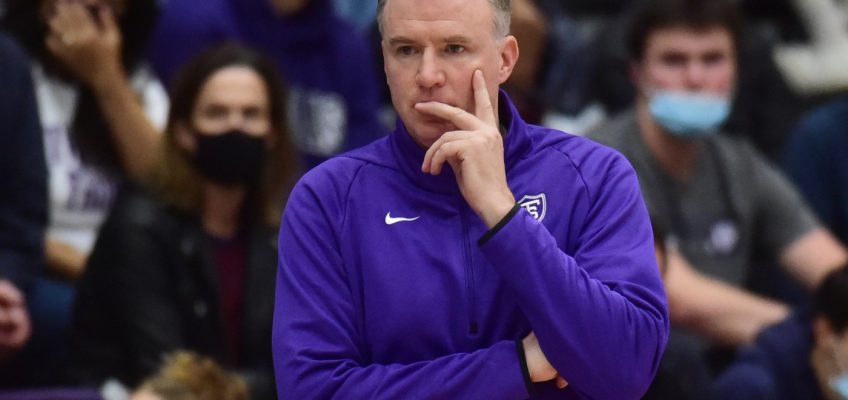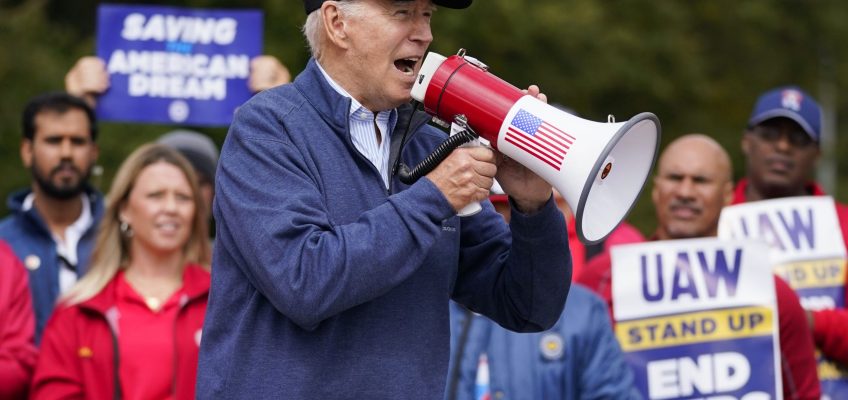When a pollster releases new data in six key battleground states, and the incumbent is losing in four of them, it’s hard to narrow down the list of warning signs to just a handful.
But the latest results from The New York Times and Siena College, released Sunday to coincide with the one-year-out mark from the 2024 election, paint a dismal picture for President Joe Biden — and a well-defined path back to the White House for the man he defeated three years ago, former President Donald Trump.
Among likely voters, Trump led Biden in four of the six battleground states (Arizona, Georgia, Nevada and Pennsylvania), tied in another (Michigan) and trailed Biden in just one (Wisconsin). Trump lost all six states in 2020. But his leads over Biden in the polls were all by at least 5 percentage points, while Biden’s advantage in Wisconsin (2 points) was well within the poll’s margin of error.
They’re not outliers in showing Biden in peril: A CBS News/YouGov national poll also released on Sunday showed Trump leading Biden 51 percent to 48 percent — a reversal of Biden’s 51 percent to 47 percent victory in the 2020 election.
The poll results have already prompted tons of handwringing among prominent Democrats within half a day of their release. But it’s not just the topline numbers that should make the party wary of next year — and potentially uneasy about the off-year elections this week.
It’s also what’s buried in the crosstabs and the other questions — specific areas of weakness for Biden on policy, personal attributes and among key segments of the electorate central to his bid for a second term.
In the spirit of the six-state survey, here are the six biggest warning signs for Biden in the numbers:
Is Biden too old?
Yes +42
It’s perhaps the central question of the 2024 election: Are voters prepared to elect a man who will be 86 years old when his term would end in January 2029?
A year before the voting ends, the answer is no. Seven in 10 likely voters in the battleground states agreed that Biden “is just too old to be an effective president.” Only 28 percent disagreed.
And even though Trump is only three years younger than Biden, voters see him as a spring chicken by comparison. Only 39 percent said the Republican frontrunner “is just too old to be an effective president,” while a 58-percent majority disagreed.
Similarly, only 36 percent of likely voters thought Biden “has the mental sharpness to be an effective president,” while 54 percent thought Trump is mentally sharp enough.
Do you think Joe Biden’s policies have helped you personally or hurt you personally?
Hurt +17
Swing-state voters are also dissatisfied with the current trajectory of the country. Only 23 percent thought the country is headed in the right direction; even among Biden supporters, they were split evenly between saying the country is on the right track (43 percent) and wrong track (42 percent).
Perhaps even more damningly, a majority of voters, 53 percent, said Biden’s policies had “hurt them personally.” Just 36 percent said they’d been helped by Biden’s policies.
By contrast, the numbers are almost a mirror image for Trump: 51 percent said they’d been personally helped by the former president’s policies, while 36 percent said they’d been hurt.
Voters under 30
Biden +6
Biden has a serious problem with young people.
Among likely voters under 30, Biden led Trump in the poll 50 percent to 44 percent. That’s still the president’s best age cohort, but it’s well short of his 2020 benchmark — or any he’d have to hit to be on track to win reelection.
The numbers suggest this is a problem specific to Biden. Young voters were the subgroup most likely to say they think Biden’s too old. And asked how they would vote if Democrats nominated a candidate other than Biden, they broke for the unnamed Democrat in larger numbers, 58 percent to 34 percent.
(Note: It’s not instructive to compare the aggregated battleground-state results to exit polls or other 2020-voter surveys, since those cover the whole nation or individual states specifically. Also, the New York Times/Siena aggregated results granted equal weight to each state individually, even though Pennsylvania has more than four times the population of Nevada, to cite the most extreme example.)
Hispanic voters
Biden +12
Biden won the lion’s share of the vote among Latino voters in 2020, but Trump made inroads among the growing demographic group compared to 2016 — and that trend is continuing in the new data.
Biden led Trump among likely voters who identified as Hispanic or Latino, 52 percent to 40 percent. Again, comparisons to 2020 exit polls are tricky since the new poll isn’t national in scope, but most estimates suggest Biden won 60 to 65 percent of the Hispanic vote in the last election.
Of the swing states included in the new polling, Arizona and Nevada contain the largest percentage of Latino voters; they rank fourth and fifth, respectively, among all states. The others — Georgia (24th), Pennsylvania (30th), Wisconsin (31st) and Michigan (38th) — contain much smaller Latino populations, but it’s still a growing voting bloc.
Most important issue
Economic issues +24
Voters typically pick their presidents based on the economy, and 2024 is shaping up to be no different.
Asked to pick between “economic issues such as jobs, taxes and the cost of living,” and “societal issues, such as abortion, guns or democracy,” a majority, 55 percent, said the economy. Only 31 percent chose societal issues.
That’s a major problem for Biden, since fully half of swing-state voters, 50 percent, rated the economy as “poor.” Only 21 percent said it was “excellent” or “good;” another 29 percent called it “only fair.”
The results are powering Trump’s advantage: More than seven in 10 Trump voters, 71 percent, said economic issues were most important to their vote, while Biden voters were more split: 50 percent said societal issues, while 38 percent chose economic ones.
And even Biden voters aren’t excited about the state of the economy. Combined, more rated it as “only fair” or “poor” (58 percent) than “excellent” or “good” (41 percent).
Should abortion be legal or illegal?
Always/mostly legal +31
How is a two-to-one advantage on the question of abortion — whether it should be always or mostly legal or illegal — a problem for Biden? Because he isn’t winning pro-abortion-rights Trump voters, even more than a year after the Supreme Court overturned Roe v. Wade.
Four in 10 likely swing-state voters, 40 percent, who picked Trump on the ballot test said they think abortion should always or mostly be legal.
To the extent abortion could help Biden mend his problems with core Democratic-leaning subgroups, it’s more likely to be useful among young voters (73 percent always/mostly legal) than Hispanics (61 percent always/mostly legal).




